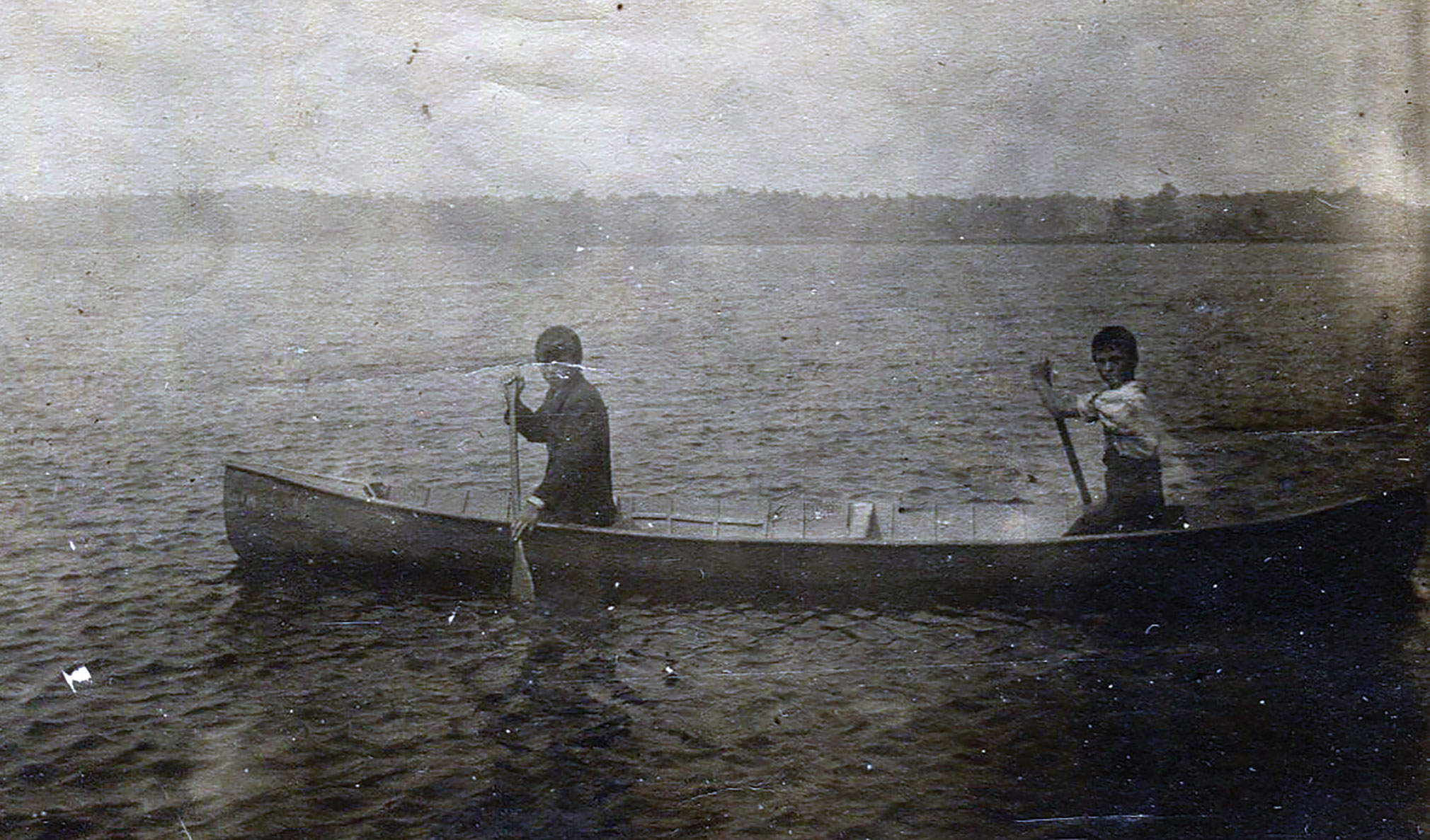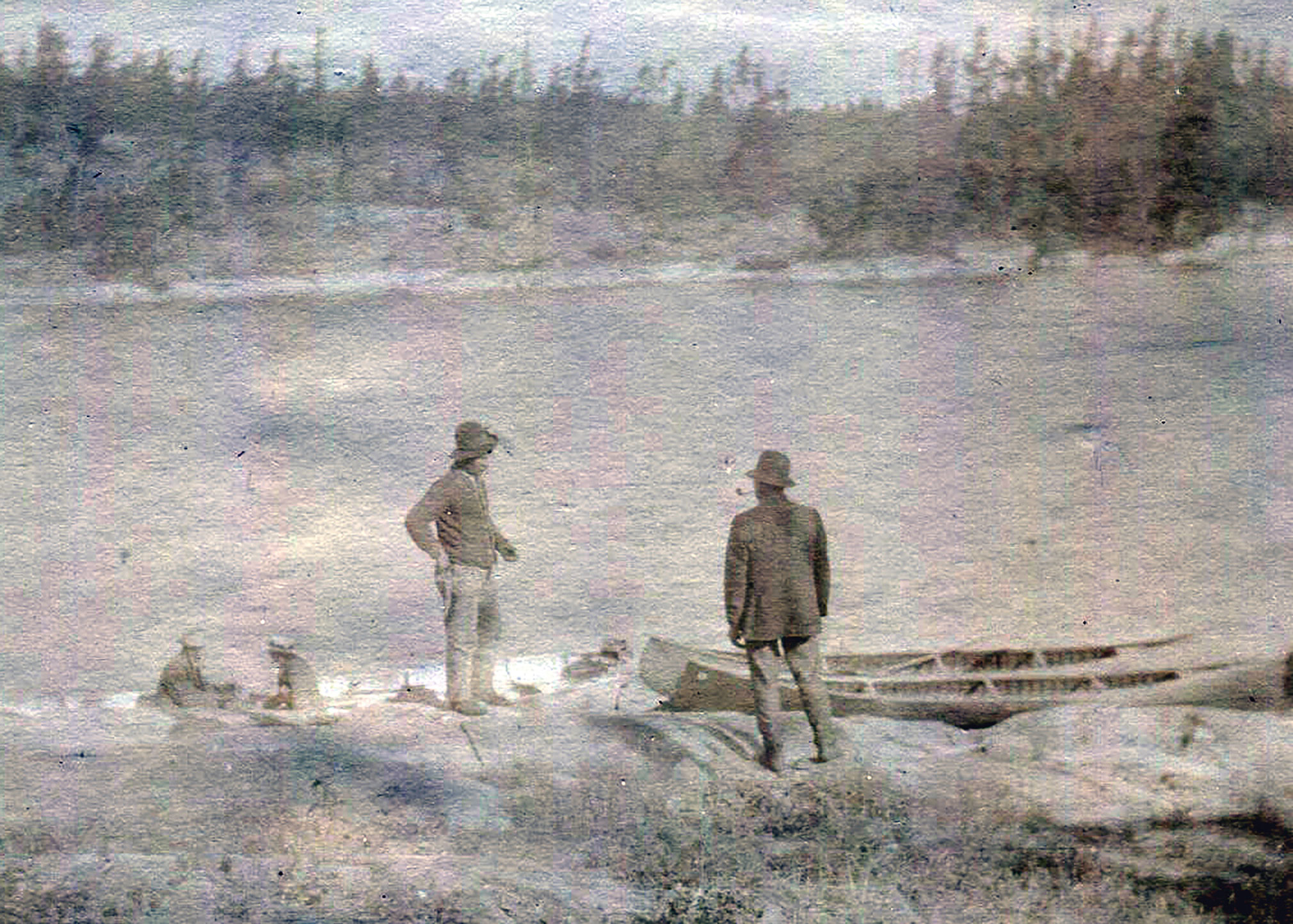Birchbark canoe build at the Georgian Bay Biosphere Canoe Build, 2019. Left Canoe: Gracie Crafts, Lara Zenhenko, and Julianna Nanibush. Wiigwaas Jiimaanke.
The Bark Canoe: A Marvel of Indigenuity
Indigenous people have been navigating the Great Lakes watershed from earliest times, as demonstrated by the location of their settlements along former and current waterways. While past and evolving forms of their watercraft have not been preserved, stone woodworking tools likely used in dugout canoe manufacture appear more than 10,000 years ago. The pinnacle of this naval architecture tradition was the birchbark canoe, a speedy vessel that was robust yet lightweight and could be easily portaged overland around obstacles or between waterways. Their fundamental skin-on-frame design remains popular today, although modern canoes are now usually constructed using synthetic materials.
Dugout canoes were too heavy to portage so would be built and used close to specific waterways. To help protect them from the elements, dugouts would be sunk in shallow water over winter and several such canoes have been recovered from lakes in Ontario. Dugouts were also made by European settlers who brought with them a similar boat-building tradition.

A Nautical Trading Tradition
Noted for their shallow draft and load-carrying capacity, bark canoes facilitated a tradition of waterborne travel and trade spanning millennia. The scalable design could produce canoes ranging from one- or two-person models, three to five metres long, up to very large models, ten to twelve metres long, capable of carrying twenty to thirty paddlers. The canot du maître, or Montreal canoe, an eleven metre birchbark canoe of Algonquin design employed by voyageurs during the fur trade, would accommodate eight paddlers with personal gear, half a tonne of provisions, and three tonnes of cargo for a total capacity of over four tonnes.

The superiority of the bark canoe over plank boats was noted by European admirers in the early 1600s, including Samuel de Champlain who travelled extensively by canoe and recognized it as an essential vehicle for backcountry travel and trade. By the early 1700s, the French employed Indigenous people to build twenty large canoes annually at a factory on the St. Lawrence River at Trois Rivières.

Tools of the Canoe Builder’s Trade
Heavy-duty woodworking tools made of ground stone first appear in southern Ontario over 10,000 years ago. Tools such as axes and hatchets would have been required for cutting and trimming poles for making dwellings, hunting weapons, and fish weirs. They would also have been used to strip bark for sheathing houses, basketmaking, and canoe building. Gouges and adzes would have been useful for making dugout canoes while chisels and wedges would have facilitated fine woodworking tasks. Amongst the most complex of fabrication activities was bark canoe building, which required a sophisticated toolkit to manufacture the many components and then assemble them.
Birch bark, ideally harvested in spring or fall, was preferred for canoes due to its elasticity when green, general lack of blemishes, and grain which ran around the tree. Bark sheets would be sewn together with black spruce roots. White cedar was preferred for the framework. Spruce gum melted and mixed with fat to retain flexibility was used for seam waterproofing.
OBJECTS GALLERY


Snowshoes
Like the bark canoe, snowshoes exhibit such simplicity and elegance of functional design that they have made the transition to modern materials with very little modification. Fabricated from wood, often ash, steamed and bent to form a circular, ovate, or tear-drop frame, with or without wooden cross bracing, traditional snowshoes all feature an interlaced web made of rawhide or sinew lacing called “babiche.” Different shapes and styles, now often attributed to various Indigenous groups, likely originated to deal with the challenges of different landscapes, like dense bush or hilly terrain.
Snowshoes would have been an essential tool for winter travel in Muskoka, which lies in one of Southern Ontario’s “snow belt” areas. Lake effect precipitation in the lee of Lake Huron deposits a mean annual snowfall of nearly three metres.


